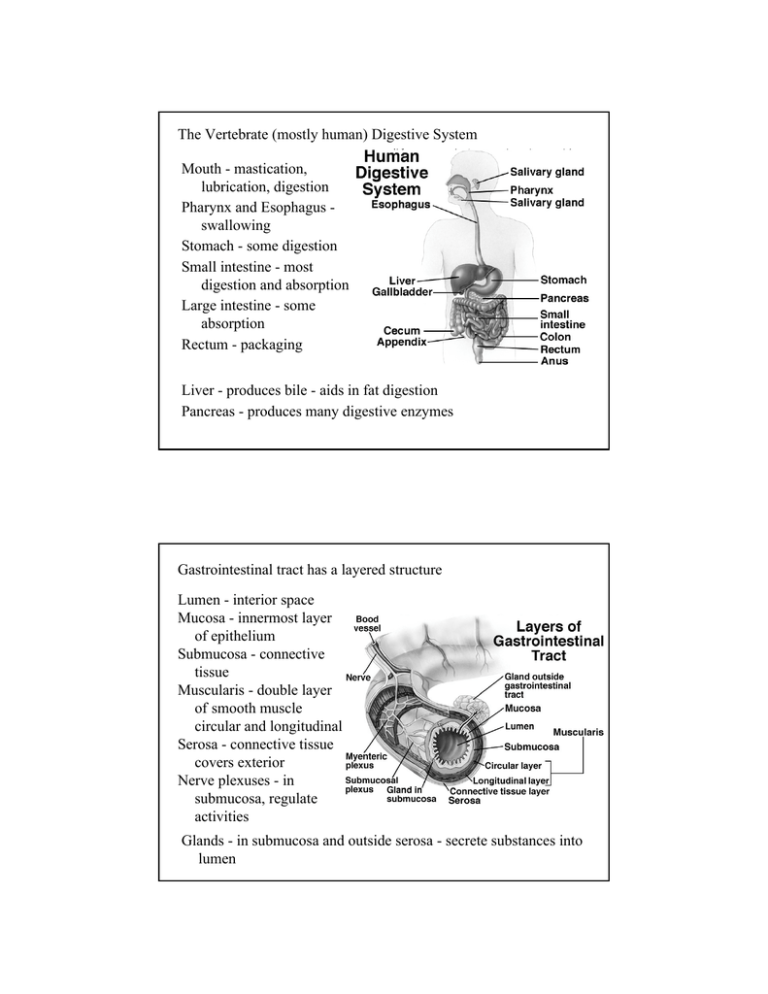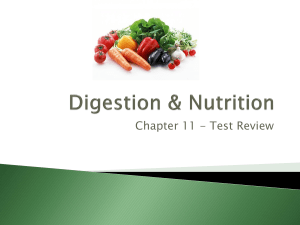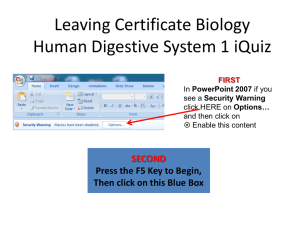The Vertebrate (mostly human) Digestive System Mouth - mastication, lubrication, digestion
advertisement

The Vertebrate (mostly human) Digestive System Mouth - mastication, lubrication, digestion Pharynx and Esophagus swallowing Stomach - some digestion Small intestine - most digestion and absorption Large intestine - some absorption Rectum - packaging Liver - produces bile - aids in fat digestion Pancreas - produces many digestive enzymes Gastrointestinal tract has a layered structure Lumen - interior space Mucosa - innermost layer of epithelium Submucosa - connective tissue Muscularis - double layer of smooth muscle circular and longitudinal Serosa - connective tissue covers exterior Nerve plexuses - in submucosa, regulate activities Glands - in submucosa and outside serosa - secrete substances into lumen The Mouth The teeth cut and grind food - mastication Tongue mixes food with saliva Salivary glands produce saliva - empty through mucosa of mouth salivary amylase initiates breakdown of starch Secretion of saliva controlled by the nervous system low level continuous secretion keeps the mouth moist high level secretion stimulated by sight, smell, or idea of food Swallowing Food passes to the back of the mouth Palate elevates, pushes against rear of pharynx Seals off nasal cavity - a good thing Pressure on pharynx stimulates swallowing center in brain Swallowing center inhibits respiration - a good thing Seals trachea - raises larynx and closes glottis with epiglottis Esophagus Upper 1/3 of esophagus enveloped in voluntary skeletal muscle Lower 2/3 enveloped in involuntary smooth muscle Food propelled by peristaltic waves of muscular contractions Entry of food into stomach controlled by gastric sphincter prevents food in stomach from re-entering esophagus Stomach Sack-like, thick walled, muscular, with highly convoluted interior mucosa smooth muscle churns food Glands in mucosa produce secrete several compounds Parietal cells secrete HCl and intrinsic factor (for B12 absorption) Chief cells secrete pepsinogen, an inactive protease Active proteases in stomach activate pepsinogen to pepsin Digestion in stomach restricted to protein digestion proteins reduced to smaller polypeptides HCl aids protein digestion by denaturing proteins Stomach produces 2 l gastric secretions/day Stomach pH = 2 No digestion of carbohydrates or fats The acidic food mixture produced in the stomach is called “chyme” Little absorption occurs in stomach - some water, alcohol, aspirin Chyme leaves stomach and enters duodenum through pyloric sphincter Capacity of duodenum is small compared to stomach Rate of dumping controlled by nervous system and hormones Small Intestine about 6 m long composed of three sections - duodenum, jejenum, ileum most digestion occurs in duodenum and jejunum Duodenum is 25 cm long - remainder is jejenum and ileum receives chyme, pancreatic enzymes, bile from liver Epithelial wall has many folds - villi Villi have cytoplasmic projections-microvilli Both increase surface area for absorption and secretion Epithelial wall also called “brush border” Brush border has embedded enzymes that hydrolyze lactose, sucrose and other sugars Accessory Organs Pancreas Pancreas - at junction of stomach and small intestine Connected via pancreatic duct Has both exocrine and endocrine functions Fluid contains many enzymes proteases (trypsin and chymotrypsin) pancreatic amylase and fat digesting lipase Enzymes released as inactive zymogens, activated by brush border enzymes Fluid also contains bicarbonate to neutralize HCl Chyme in intestine becomes slightly alkaline Absorption in the Small Intestine Amino acids and simple sugars transported across brush border - through epithelial cells and into capillaries within villi Blood carries digestion products to liver via hepatic portal vein Fats hydrolyzed into fatty acids and monoglycerides Absorbed by intestinal epithelium and reassembled into triglycerides New fats combined with proteins to form watersoluble chylomicrons Absorbed into lymphatic capillaries Contents of lymphatic system enter blood stream in veins near neck Each day 9 liters of chyme passes small intestine Nearly all fluids and solids are absorbed 8.5 liters absorbed in the small intestine 350 milliliters reabsorbed in the large intestine 50 grams of solids and 100 milliliters of liquid leave as feces Large Intestine (colon) Has no digestive function absorbs 4% of fluids Surface lacks villi about 1 m long Harbors symbiotic bacteria Absorbs sodium, vitamin K, other products of bacterial metabolism Small intestine empties into large intestine through ileocecal valve just above cecum and appendix Primary function is to compact and store feces Bacteria are incorporated into feces Bacterial fermentation produces gas Human colon evolved to process food with high cellulose content Low fiber diets result in slower passage of food through colon May be associated with high level of colon cancer in U. S. The rectum - terminal portion of the large intestine Feces pass into rectum by peristaltic contractions Material exits anus through two sphincters First sphincter is smooth muscle, opens involuntarily Second sphincter is striated muscle under voluntary control - a very good thing Accessory Organs Pancreas - at junction of stomach and small intestine Connected via pancreatic duct Has both exocrine and endocrine functions Fluid contains proteases (trypsin and chymotrypsin) pancreatic amylase and fat digesting lipase Enzymes released as inactive zymogens, activated by brush border enzymes Fluid also contains bicarbonate to neutralize HCl Chyme in intestine becomes slightly alkaline Pancreas is also an endocrine gland Produces hormones that regulate blood sugar level Produced in islets of Langerhans clustered throughout pancreas Most important pancreatic hormones are insulin and glucagon Insulin - produced by β-cells released in response to high blood sugar stimulates sugar uptake by liver and muscles - converted to glycogen Glucagon - produced by α-cells released in response to low blood sugar stimulates release of sugar from liver - from stored glycogen Liver and Gallbladder Main secretion of liver is bile a fluid with bile pigments and bile salts Bile pigments are waste products from destruction of red blood cells Bile salts are lipid and water soluble Emulsify fats Allows faster digestion of fat Bile is stored and concentrated in gall bladder Fatty food in duodenum triggers contraction of gallbladder to release bile Contraction of gallbladder may result in pain under right shoulder blade Regulatory Functions of the Liver Hepatic portal vein carries blood from stomach and intestine to liver Liver absorbs or chemically modifies substances Alcohol, drugs, toxins metabolized by liver cells Ammonia from intestinal bacteria converted into urea Controls level of many substances produced by body Steroid hormones converted into less active forms Terminal products of metabolism eliminated in feces or through kidneys Produces proteins found in blood plasma Includes most blood clotting factors Maintains blood protein concentration within narrow limits Neural and Hormonal Regulation of Digestion Nervous Control Sight/Smell of food stimulates salivary and gastric secretions Hormonal Control Food in stomach stimulates secretion of gastrin by stomach Gastrin stimulates secretion of pepsinogen and HCl Low stomach pH reduces secretion of gastrin Passage of chyme from stomach inhibits stomach contractions Process mediated by neural impulses and enterogastrone proteins Gastric inhibitory peptide (GIP) is one enterogastrone GIP released by duodenum Production stimulated most strongly by fat in chyme Cholecystokinin (CCK) is secreted in response to fat in chyme Stimulates contraction of gallbladder to release bile Secretin released in response to low pH chyme Stimulates pancreas to release bicarbonate and enzymes









